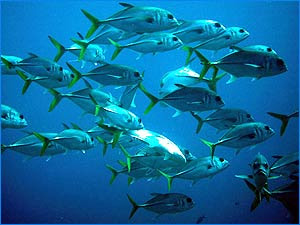
In nine days I am going to fly from the fishing village of Igiugig to a remote reef atoll to cook for marine biologists and the research support team. Photo above by Vayama - International Travel
In total there will be 8 mouths to feed... a captain, security guard, a few scientists and students. Their current line of research is dealing with stingrays and coral, I will learn plenty more while down there, so I will keep it at that for now. I will be living and working at the Glover's Reef Atoll Research Station operated by the Wildlife Conservation Society and designated a World Heritage Site by UNESCO. There are only 176 physical World Heritage Sites in the world, this being on of them due to it's biological diversity and richness.
"The Belize Barrier Reef is a World Heritage Site. Glover’s Reef is home to Belize’s largest "no-take" marine reserve, where fishing is prohibited. It is one of the only true atolls—strings of coral islands surrounding a pristine lagoon—in the Atlantic Ocean. Though the species is now greatly depleted across the Caribbean, Nassau grouper once gathered at Glover’s Reef by the tens of thousands.Evidence of preclassic Maya settlements and shipwrecks indicate that early explorers once traveled here and that these waters were on the route of the slave trade."
I am excited to learn a bit about how the no-take marine reserve works and what the results have been regarding the biology of the reef system. For years at university I argued for more marine wilderness zones since there are barely any, lots on land, few in the oceans. The ocean wild is just as, if not more, important as the terrestrial wilderness. I've read furthermore into the fishing policies of Belize, there are 13 organizations that work together to monitor, protect, and create catch sizes for local fishermen. With so many eyes on the marine playing field conservation is sure to take hold.
"Threats and Challenges - Like coral reef systems around the world, the Glover’s Reef Seascape faces serious impacts from overfishing, pollution, unregulated tourism, and climate change. These threats can destroy corals, deplete fish stocks, and weaken ecological links across the seascape. As local fish stocks in neighboring Guatemala and Honduras have crashed, foreign fishers increasingly turn to the healthier waters of Belize, placing additional pressure on Glover’s Reef. As one species after another is fished to critically low levels, the impacts cascade across the entire fish community and reef system. Lack of coordinated management strategies, sparse enforcement, and insufficient resources to effectively manage the area complicate matters more.
Dredging, vegetation clearing, and waste dumping caused by unregulated coastal and caye development also destroys critical seagrass beds, corals, and mangroves in the seascape. With climate change anticipated to cause harmful bleaching in 70 percent of coral reefs worldwide by 2100, Belize’s coral reefs are at a tipping point.
WCS Responds - WCS is working with partners in Belize to conserve the Glover’s Reef Seascape through field science, policy expertise, and strong local partnerships. Field investigations on species like Nassau grouper, hawksbill turtles, and queen conch are used to guide new laws and policies designed to conserve the seascape. Our research station, situated on Middle Caye at Glover’s Reef, is on the front lines of conservation of this remote seascape. It provides both a base of operations for enforcement and monitoring as well as a field research and training station for visiting scientists.
WCS and its partners have helped to pass new laws that mandate year-round protection for the Nassau grouper at 11 sites; established a program that trains local fishermen to collect data; and helped complete the country’s new National Protected Area Policy and System Plan."
"Glover's Reef Atoll, the southernmost of Belize's offshore atolls, located approximately 45 km off the mainland, is oval-shaped and runs 32 km long and 12 km wide. The Atoll is considered the prototypic atoll of the Caribbean. It is not only the best developed biologically, but also possesses the greatest diversity of reef types. Its deep lagoon is studded with about 850 patch reefs and pinnacles rising to the surface. Six sand cayes lie on the reef crest along its southeastern edge. The peripheral reef of the Atoll is broken in only three places by deep channels, allowing for the tidal flow of water between the lagoon and the open sea. A large grouper spawning site is located at the northeastern end of the atoll.
The Wildlife Conservation Society runs the Glover's Reef Research Station on Middle Caye. Since opening in 1997, the Station has hosted more than 100 scientific expeditions and has served as a platform for many researchers and students. The Station's mission is to promote long-term conservation and management of the Belize Barrier Reef complex through in-situ research, cooperative management, training, and education."
Below are bits and pieces from two resorts nearby the research station. The first one is Slickrock Adventures. More details, photo credits, and info on Belize food can be found by clicking here.
 I've gone over what this Chef has cooked, very similar to Costa Rican food... lots of fresh fruits and veggies, beans, rice, tortillas, salsas, nachos, fried fish, etc.
I've gone over what this Chef has cooked, very similar to Costa Rican food... lots of fresh fruits and veggies, beans, rice, tortillas, salsas, nachos, fried fish, etc.  Here is another great resort. More details on Glover's Atoll Resort and photo credits can be found by clicking here.
Here is another great resort. More details on Glover's Atoll Resort and photo credits can be found by clicking here. 


































